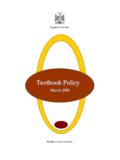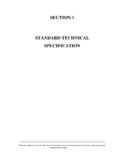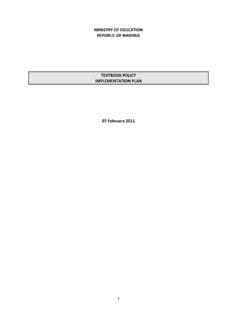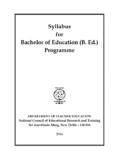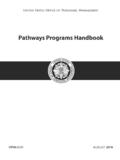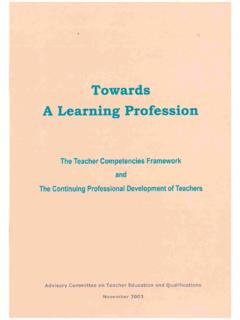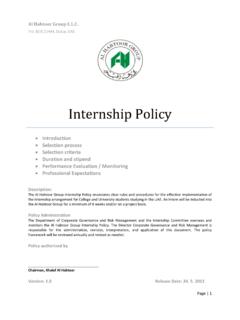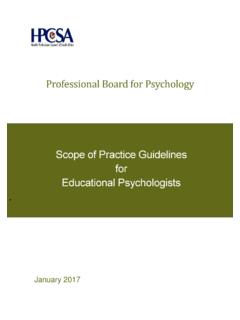Transcription of Table of Contents - MCA Namibia
1 Table of 1: Why standards? Introduction ETSIP A Rationale for ETSIP ETSIP: Programme Overview A Model for Teacher Training and Development in 2: What is a standard? Introduction What is the NQF (National Qualifications Framework)? What are standards? Information Presented in the Professional Standards for 3: What do the standards mean for me? Introduction The Standards Intern and Professional Teachers Licensed Teachers Who will measure me against the National What is the role of School Standards for School Opportunities for professional Exciting 4: Meeting the challenge Introduction Will standards help to retain good quality teachers? What if I was never trained in these competences?
2 What can I do right now? How could I lose my license, and what does that mean for me? What will I do, as a school manager, if most of my teachers become unlicensed?20202121222223 CHAPTER 1:Why standards?In this look at:! A model for teacher development! The ETSIP document! Education s contribution to Vision2030! Plans to develop teacher competenceIntroductionIn order to answer the question, Why standards it is necessary to look at thedevelopment of Namibia at a more strategic level. In August of 2005 the Government ofNamibia released an exciting and ambitious strategic plan for the delivery of Vision passages below quote directly from that document, available on the NIED to the strategy is the Education and Training Sector Improvement Programme(ETSIP), focus of many of the note:Passages quoted from Vision 2030 and the ETSIP document in this chapter are selectedpassages, and as a result, the numbering may not be sequential.
3 Perhaps points 1, 3 and 6are quoted, and 2, 4 and 5 omitted because they are not relevant to the NationalProfessional Standards For 1: Why Standards?Education and Training Sector Improvement Programme (ETSIP) Education and training in Namibia is at a turning have analysed the education and training system in detail. Although the many positivedevelopments, achievements and the progress in the sector over the last 15 years arerecognised and appreciated, the analysis focused on the shortcomings of the system inorder to enable us to design an improvement programme. We now know what is workingand what is not working. Indeed, it has been shown, quite alarmingly, that too many of ourchildren are not gaining the basic skills of functional literacy.
4 Progress towards equityin education has not been rapid enough. More than that, at the current level ofperformance in education, we will not be producing citizens who are capable of makingNamibia a knowledge-based economy as is expected of us in Vision We have taken time, as this document shows, to set objectives and to plan what we mustdo to turn the system around and bring about big improvements. Namibia has never beforehad such a detailed, complex and broad-based plan of action for education. In fact, readersshould be aware that for each component mentioned here there is a detailed programmesetting out what should be done by whom and by when to achieve time has therefore come for ETSIP to be implemented with energy, and for the effectsto be felt on the ground, in the schools and colleges, in vocational training centres, andwherever organized learning is taking place.
5 Education systems are always difficult tochange; they are so huge and involve almost every one of us personally. It is therefore veryimportant that all of us go about this historic change in education with clarity,determination and unity of purpose. After all, how successful we are in the educationsystem will largely determine how successful we are in creating that better future that welong A Rationale for ETSIP (selected quotations)1. Inspired and guided by our national vision statement, Vision 2030, Namibia is currentlyundergoing a dramatic reform of its overall national development strategy. Vision 2030sets a very ambitious target that, by 2030, Namibia should join the ranks of high incomecountries and afford all its citizens a quality of life that is comparable to that of thedeveloped world.
6 With emphasis on enhanced quality of life for all, Vision 2030 callsfor the intended rapid economic growth to be accompanied by equitable socialdevelopment. These twin goals of growth with equity are to be pursued within a broaderstrategic framework of transforming the economy into a knowledge-based Shortages of skilled labour persist within a context of unmet labour market the demand for labour, a key constraint lies on the supply side - or basically, theeducation and training 1: Why Standards?7. Other than economic benefits, an effective education and training system has well-documented broader benefits that are critical to development. These benefits include:poverty reduction and social equity; social vaccine for HIV/AIDS; improved absorptivecapacity for other social services, including health and education itself; low fertilityrates; higher use of contraceptives; better social participation and the resultantparticipatory democracy; and good The expected economic and social benefits of education notwithstanding, recentanalyses have characterised Namibia s education and training system as a very weaktool for supporting the realisation of national development goals, especially the intendedtransition to knowledge-driven growth and equitable social development.
7 In a nutshell,the current education and training system is not able to rise to the call of Vision2030, and heighten its contribution to the actualisation of Vision 2030, and therealisation of national development : Programme Overview (selected passages)ETSIP is based on a realisation that a weak education and training system cannot facilitatethe attainment of complex and ambitious development goals. ETSIP represents a sustainedresponse of the sector, based on a fifteen-year strategic plan accepted by the NamibianGovernment in first phase of ETSIP will strengthen the quality, effectiveness, and efficiency of thegeneral education and training that will operationalise the quality improvement element of the above sectorstrategic goal include:Component 1.
8 Learning standards and curricula .. strengthening of educators to ensure that they can effectively facilitate theacquisition of set skills and 2. Teacher professional development and incentivesObjective: (a) Teacher competencies strengthened in subject mastery and first step towards improved teacher performance is to define the competenciesrequired and develop teacher standards. A second step is to implement thecurrently planned system of teacher licensing. Finally, incentives of various kinds willbe developed within the means 1: Why Standards?A Model for Teacher Training and Development in NamibiaThe National Professional Standards for Teachers in Namibia will bring about a newapproach to teacher training and development.
9 From now education and development will be based on the National providers Universities, Colleges and private providers will all berequired to align their curricula, programmes and qualifications to meet the requirementsof those providers will need to be accredited by the Namibian QualificationsAuthority (NQA) before offering programmes of learning towards the NationalStandards. This applies to in-service teacher training providers as qualification teachers obtain at the end of pre-service training will allow teachers toenter into a managed internship, in a supportive environment. Intern Teachers will workover a two-year period to achieve a Professional teachers will also be supported as they work towards new will also have new career opportunities as mentors, support teachers, andteacher Professional Qualification awarded at the end of the internship will equip teachersto become licensed (registered) at TeacherTraining Institution[Subject Knowledgeand Teaching Skills]Intern Teacherappointed to asupportive schoolProfessional Teacher.
10 Registered andlicensed to teachOngoing ProfessionalDevelopmentVarious career streamsEntrance criteria setnationally for all candidateteachers School leaver Mature entrant GraduateLearning Programmesbased on NationalStandards for TeachersAssessed against theNational StandardsIn-service programmesbased on NationalStandards for TeachersAssessed against theNational StandardsAssessed against theNational StandardsLicensing: Maintaincompetence in terms of theNational StandardsInstitution / Schoolaccredited by the NQAA Standards-based Model for TeacherEducation and DevelopmentChapter 1: Why Standards? Qualifications after pre-service training, and at the end of the internship willbe registered on the National Qualifications Framework (NQF).




